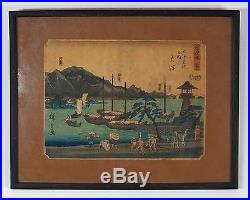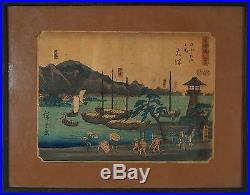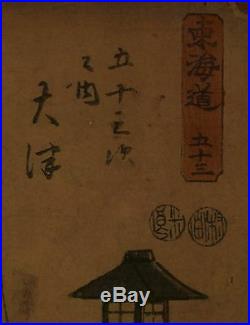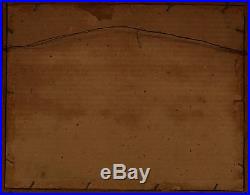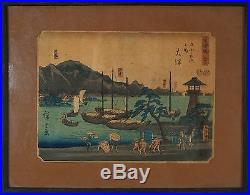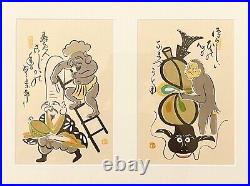
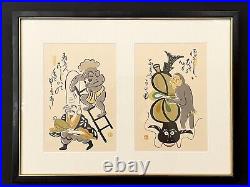
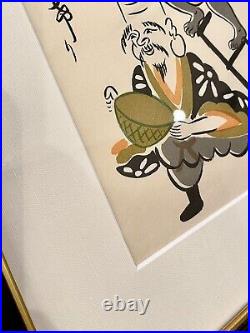
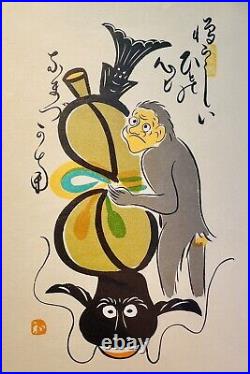
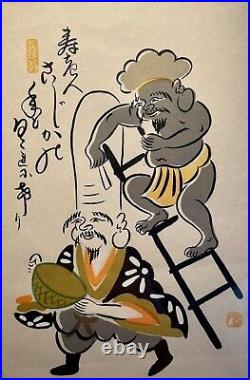


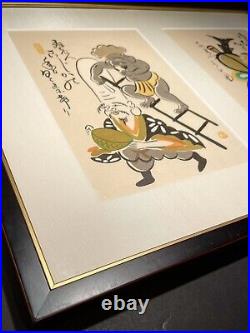
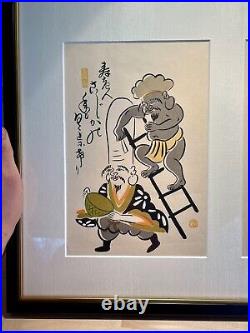


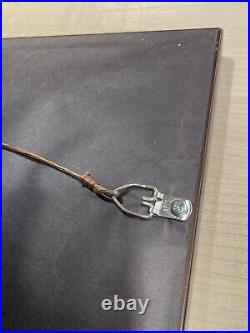
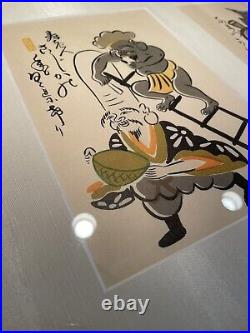
2 Vintage Otsu-e Handcrafted Woodblock Prints. Travel back in time to the charming city of Otsu with these exquisite vintage Otsu-e woodblock prints! Handcrafted with Japanese pigments on brown paper, these souvenirs were created for travelers passing through the city and are now a rare gem to add to your collection. The first print, “The ladder-shaving of Goho and Daikoku, ” is a satirical picture with the effect of “obtaining long life, ” while the second print, “Gourd Catfish, ” brings together the peaceful interaction of fish and water. Both prints come professionally framed, matted, and under conservation glass, preserving their beauty and ensuring they remain in excellent vintage condition. Own a piece of history with these incredible Otsu-e prints! Measures: 14″ x 19″. Both prints are in excellent vintage condition. The glass is conservation grade. Please see the pictures for additional details. Artwork #1 detailed description. Title: “The ladder-shaving of Goho and Daikoku”???????? Goho refers to the character of Jurojin in this picture. When it comes to representative motifs of Otsu-e, nowadays “Kokeshi of Frosty Incantation” and “Fuji Musume” readily come to mind. However, originally this “The ladder-shaving of Goho and Daikoku (Jurojin)” was also quite a popular subject. The figure of Daikoku, who sets a ladder on the head of Jurojin, the elder with a long, bald head, and shaves his bald head, may have been a simple caricature at first, but from around the middle period of the Edo era, it began to be drawn as a satirical picture and was accompanied by the teachings of a Kokugaku scholar set to a children’s song. “Jurojin, the year of the fawn, has also come to an end” “Both Fukurokuju (fukunokami) and Jurojin (shoukokushin) have climbed to the top and are almost naked and about to slip”. “Prideful, high heads are shaved with a ladder, and hair falls like snow”. It can be interpreted as meaning that pursuing wealth (Daikoku) alone is harmful to longevity (Jurojin), but it can also be understood as the importance of controlling desire in moderation (shaving). In any case, it is a representative motif selected among the ten kinds of Otsu-e and is said to have the effect of obtaining long life. Artwork #2 detailed description. In Otsu-e paintings, demons often appear, but monkeys are also a common subject. The oldest painting with a monkey is the Blue-Faced Vajra, a god of Koshin belief, but the most famous is the Gourd Catfish picture. Once upon a time, the shogun Ashikaga Yoshimochi had the Zen painter Nyozekyo draw a Zen painting of a gourd catfish (a national treasure), which is now at Myoshin-ji Temple in Kyoto. In that picture, an old Buddhist monk in a short coat is holding a gourd and trying to catch a catfish, and there is no monkey. The reason Otsu-e replaced the catfish with a monkey was to get a laugh. The original meaning of the picture is not clear, but it is said to satirize the fickle nature of human beings with the phrase even the hateful heart is like a catfish. Humans have often compared those with a bit less wisdom to monkeys and teased them, but in today’s world, there are many aspects of human wisdom and behavior that are similar to monkey wisdom, and this picture makes us think about that. The technique of satire by substituting the image of a demon or monkey for a human figure is the same, and “Gourd Catfish” was chosen as one of the ten representative Otsu-e pictures due to its popularity. This topic has been conveyed in various styles, and the above picture is currently the most beloved. It is said that it has the power to resolve all matters peacefully and bring together the peaceful interaction of fish and water. This item is in the category “Art\Art Prints”. The seller is “vitaliy1997″ and is located in this country: US. This item can be shipped to United States, New Zealand, Fiji, Papua New Guinea, Wallis and Futuna, Gambia, Malaysia, Taiwan, Poland, Oman, Suriname, United Arab Emirates, Kenya, Argentina, Guinea-Bissau, Armenia, Uzbekistan, Bhutan, Senegal, Togo, Ireland, Qatar, Burundi, Netherlands, Slovakia, Slovenia, Equatorial Guinea, Thailand, Aruba, Sweden, Iceland, Macedonia, Belgium, Israel, Liechtenstein, Kuwait, Benin, Algeria, Antigua and Barbuda, Swaziland, Italy, Tanzania, Pakistan, Burkina Faso, Panama, Kyrgyzstan, Switzerland, Djibouti, Chile, China, Mali, Botswana, Republic of Croatia, Cambodia, Indonesia, Portugal, Tajikistan, Vietnam, Malta, Cayman Islands, Paraguay, Saint Helena, Cyprus, Seychelles, Rwanda, Bangladesh, Australia, Austria, Sri Lanka, Gabon Republic, Zimbabwe, Bulgaria, Czech Republic, Norway, Côte d’Ivoire (Ivory Coast), Kiribati, Turkmenistan, Grenada, Greece, Haiti, Greenland, Yemen, Afghanistan, Montenegro, Mongolia, Nepal, Bahamas, Bahrain, United Kingdom, Bosnia and Herzegovina, Hungary, Angola, Western Samoa, France, Mozambique, Namibia, Peru, Denmark, Guatemala, Solomon Islands, Vatican City State, Sierra Leone, Nauru, Anguilla, El Salvador, Dominican Republic, Cameroon, Guyana, Azerbaijan Republic, Macau, Georgia, Tonga, San Marino, Eritrea, Saint Kitts-Nevis, Morocco, Saint Vincent and the Grenadines, Mauritania, Belize, Philippines, Democratic Republic of the Congo, Republic of the Congo, Colombia, Spain, Estonia, Bermuda, Montserrat, Zambia, South Korea, Vanuatu, Ecuador, Albania, Ethiopia, Monaco, Niger, Laos, Ghana, Cape Verde Islands, Moldova, Madagascar, Saint Pierre and Miquelon, Lebanon, Liberia, Bolivia, Maldives, Gibraltar, Hong Kong, Central African Republic, Lesotho, Nigeria, Mauritius, Saint Lucia, Jordan, Guinea, Canada, Turks and Caicos Islands, Chad, Andorra, Romania, Costa Rica, India, Mexico, Serbia, Kazakhstan, Saudi Arabia, Japan, Lithuania, Trinidad and Tobago, Malawi, Nicaragua, Finland, Tunisia, Uganda, Luxembourg, Brazil, Turkey, Germany, Egypt, Latvia, Jamaica, South Africa, Brunei Darussalam, Honduras.
- Artist: Otsu-e
- Unit of Sale: Set
- Image Orientation: Landscape
- Size: Medium
- Signed: Yes
- Title: 外法と大黒の梯子剃, 大津絵 瓢箪鯰
- Period: Art Deco (1920-1940)
- Framing: Matted & Framed
- Original/Licensed Reprint: Original
- Region of Origin: Japan
- Subject: Humor
- Personalize: No
- Type: Print
- Year of Production: 1936
- Item Height: 14 in
- Style: Folk Art
- Theme: Art Print
- Production Technique: Woodcut Printing
- Country/Region of Manufacture: Japan
- Culture: Japan
- Item Width: 19
- Handmade: Yes
- Time Period Produced: 1925-1949
